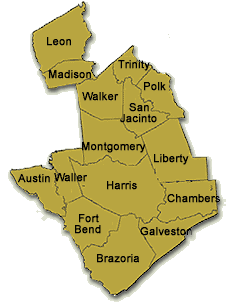
|
 |

Region H
2005 Regional Water Plan Overview

Regional Facts

Major Cities | Houston, Galveston, Brazoria, Texas City |
| Population: 2000 | 4,848,918 |
| Population: 2060 | 10,897,526 |
| Total Water Use: 2000 | 2,087,409 Acre-Feet |
| Total Water Use: 2060 | 3,412,457 Acre-Feet |
| Primary Rivers | San Jacinto, Trinity, Brazos, Neches-Trinity, Trinity-San Jacinto, San Jacinto-Brazos |
| Major Aquifers | Gulf Coast, Carrizo-Wilcox |
| Annual Precipitation | 40-60 Inches |
| Net Evaporation | 16-28 Inches |
Basic Plan Facts
- Population in this planning area is projected to more than double from 2000 to 2060
- Total capital cost of proposed water supply measures: Not available
- One new major reservoir proposed in the region: Allen's Creek Reservoir which would inundate approximately 7,000 acres of land. Two additional reservoirs are included in the plan as "alternative water management strategies": Bedias Reservoir, and the on-channel Little River Reservoir which would be located outside the region in Milam County.
What's at Issue?
For a number of reasons, this region provides an example of tentative steps in the right direction. First, it was one of only a handful of regions that incorporated advanced conservation measures into their planning efforts. Despite this focus, there is still more room for conservation related efforts that should be associated with recommended interbasin transfers and during the potential conversion of irrigation water to meet municipal needs. Secondly, Region H is one of the only a few regions to designate stream segments with "unique ecological value." While seemingly a bold step for the protection of the region's natural resources, the designations seem to only include those segments that would not be adversely affected by proposed strategies. Lastly, this region was one of only a few to include serious discussions of the need for freshwater inflows into the bays and the only one that included actual proposed inflow amounts. The discussion included an overview of the necessary inflows for the Galveston Bay System. Unfortunately, the plan fell short when it came to evaluating proposed water supply strategies for effects on environmental water needs.
Action Items
Here are some of the items the Region H Planning Group must address.
 Conservation and Drought Management Conservation and Drought Management
For conservation and drought management, the plan needs to...
- Include conservation water management strategies for all recommended interbasin transfers.
- Include drought management as a water management strategy. Each water user group with a shortage should use a drought management strategy derived from its drought management plan as a way to meet their water needs. The regional plans in the state are based on a drought of record and it only makes sense that drought management should play a large role in planning to meet the region's water needs during that drought period.
 Environmental Flows Environmental Flows
To secure the protection of flows for fish and wildlife, the plan needs to...
- Evaluate proposed water supply strategies for affects on environmental flows. The plan recommends water management strategies that would result in the destruction of bottomland hardwoods, wetlands, and other important wildlife habitat and fails to consider the potential implications on oyster beds and productivity in the Galveston Bay system.
- Reassess potential "unique stream segments" recommended by the TPWD for designation. The Texas Parks and Wildlife Department recommends 27 segments for designation in this region, while the regional plan only proposes six.
 Wildlife Habitat and Farmland Protection Wildlife Habitat and Farmland Protection
To avoid destroying valuable wildlife habitat and productive farmland, the plan needs to...
- Avoid recommending construction of unnecessary reservoirs. While the group withdrew its recommendations to construct the on-channel Little River Reservoir and the Bedias Reservoir, they are still included in the plan as "alternative water management strategies."

|
 |

|
 |



 Region H
Region H